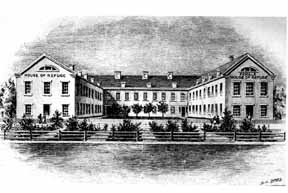| |
| 1800-1861
The
Beginnings of the Juvenile Justice System
The detention of juveniles in New York City began shortly
after the New York State Penitentiary opened its doors
in 1797. Since juvenile crimes were rare at that time,
the state preferred for parents to deal with the disciplinary
issues involving their own children; a practice rooted
in English Common Law.
Parental
authority was the accepted first tenet of youth treatment,
and the state was hesitant to assume the failing parent's
duties. By the beginning of the 19th century, however,
attitudes toward the treatment of crime had changed.
The state, it was thought, could serve as a rehabilitation
tool, rather than simply the arbiter of punishment.
Juvenile
Justice historian Merrill Sobie explains: "A
reform of the Age of Enlightenment, imprisonment was
predicated on the theory that criminals could be rehabilitated
through solitude, reflection, and religious training."
|
| |
Accordingly,
juveniles began to be tried in criminal courts. If
imprisonment could help the adult criminal, it was thought, then it
would surely assist a youth less practiced in crime.
Imprisoning juveniles, however, mixed impressionable
youths with more seasoned adult criminals.
Reformers quickly recognized the need for the separate
detention of youth as a necessary step toward the
achievement of their rehabilitative ideal.
Thus, Juvenile
Justice began in New York with the adoption of two
similar, yet substantively different principles; that
delinquents could be rehabilitated, and that they
must be held separately from older, worldlier criminals.
In the
early 19th century, the New York Society for the Prevention
of Pauperism began to lobby intensively for a separate
juvenile justice institution modeled on the prison
system.
Like many
upper-class New Yorkers faced with the City's rapid
population growth, members of the Society had become
concerned that the pursuit of commerce would overshadow
the quest for moral principles. Their efforts led
the New York State Assembly to approve construction
of The House of Refuge for delinquent children in
1824.
|
 An
1825 Lithograph of the HOUSE OF REFUGE, located at
Broadway and 23rd Street. This building is believed
to be the City's first juvenile detention facility,
housing both delinquent boys and girls.
An
1825 Lithograph of the HOUSE OF REFUGE, located at
Broadway and 23rd Street. This building is believed
to be the City's first juvenile detention facility,
housing both delinquent boys and girls.
(HOUSE
OF REFUGE,Lithograph, New York Historical Society,
negative number 20820)
|
| The House
was to be operated by the Society for the Reformation
of Juvenile Delinquents, which the Assembly incorporated
as a subsidiary of the Society for the Prevention of
Pauperism. The
House of Refuge opened on January 1, 1825, at the
intersection of Broadway and 23rd Streets, then a
semi-rural area of Manhattan. For 35 years, any child
in the state convicted of committing a criminal offense
was sent to the House of Refuge in lieu of imprisonment.
In 1851,
the Children's Aid Society built the New York Juvenile
Asylum to house children under the age of 12.
|
 The
New York Juvenile Asylum located at Tenth Avenue and
176th Street. Incorporated by a legislative act in
1851, the New York Juvenile Asylum provided residential
care for the very young.
The
New York Juvenile Asylum located at Tenth Avenue and
176th Street. Incorporated by a legislative act in
1851, the New York Juvenile Asylum provided residential
care for the very young. |
| 1861-1916
> |
|
|
